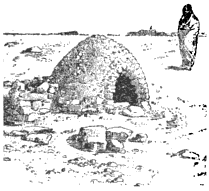Horno
_at_Taos_Pueblo_in_New_Mexico_in_2003.jpg)

Horno (/ˈɔːrnoʊ/ AWR-noh; Spanish: [ˈoɾno]) is a mud adobe-built outdoor oven used by Native Americans and early settlers of North America. Originally introduced to the Iberian Peninsula by the Moors, it was quickly adopted and carried to all Spanish-occupied lands.[1] The horno has a beehive shape and uses wood as the heat source.[2] The procedure still used in parts of New Mexico and Arizona is to build a fire inside the horno and, when the proper amount of time has passed, remove the embers and ashes and insert the bread to be cooked. In the case of corn, the embers are doused with water and the corn is then inserted into the horno to be "steam"-cooked. When cooking meats, the oven is fired to a "white hot" temperature (approximately 650 °F or 340 °C), the coals are moved to the back of the oven, and the meats placed inside. The smoke-hole and door are sealed with mud. A twenty-one-pound turkey will take 2½ to 3 hours to cook.[2] It comes out very succulent. Since the horno is made of adobe, it wicks the moisture into the food in a natural convection.
Horno is the usual Spanish word for "oven" or "furnace", and derives from the Latin word furnus.
This kind of oven was very common in Central Europe, especially in Hungary, and in these days is becoming trendy once again. The Hungarian name for the horno is kemence.
It is quite common in Argentina and Uruguay rural areas, from colonial times to our days, and it is called horno de barro, literally "mud oven".
See also
References
- ↑ Green, Rayna (1999). The British Museum Encyclopedia of Native North America. London: British Museum Press. p. 4. ISBN 0-253-33597-3. Retrieved 2 June 2012.
- 1 2 Mary Ellen Snodgrass (2004). Encyclopedia of Kitchen History. Fitzroy Dearborn. pp. 493–494. ISBN 1-57958-380-6. Retrieved 15 June 2012.